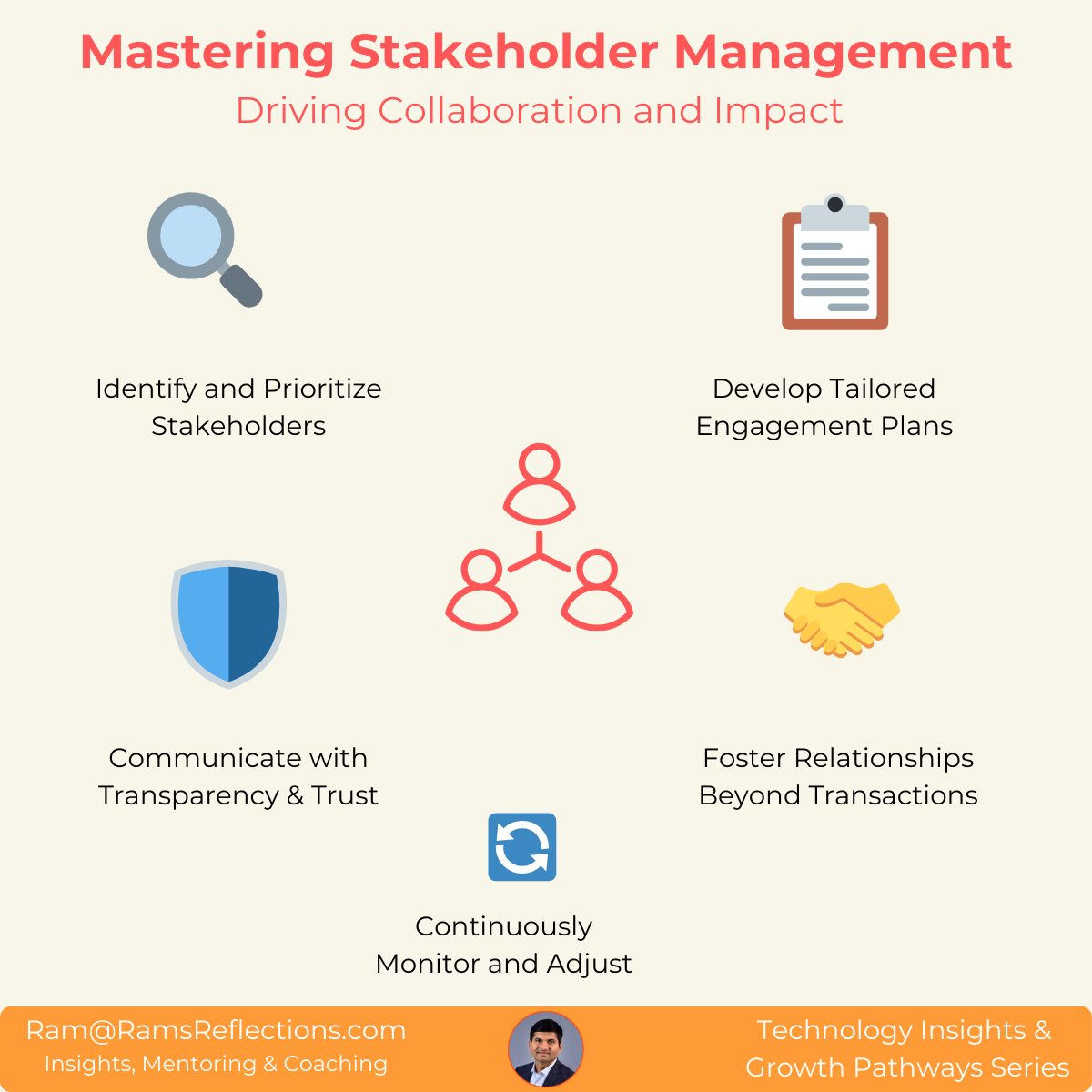Mastering Stakeholder Management: Driving Collaboration and Impact
Stakeholder management powers collaboration by aligning needs, building trust, and fostering relationships. PMI principles guide tailored plans, transparency, and adaptability for success.
'Collaborative spirit' is what I’m known for, both at work and in my professional network. But here’s the real insight: collaboration is the outcome, not the process. It’s 'stakeholder management'—how I understand and apply it daily—that truly powers collaboration. By aligning my actions with stakeholder needs, concerns, and expectations, I’ve built trust, nurtured relationships, and created environments where collaboration thrives.
In 2014, during my pursuit of the 𝐏𝐠𝐌𝐏 (Program Management Professional) credential from PMI, I was introduced to stakeholder management principles. Since then, these principles have become the cornerstone of my approach—whether leading transformation programs, managing technology, data, and security portfolios, architecting enterprise solutions, or overseeing service delivery and cloud migrations. These principles are universally applicable, regardless of the initiative or domain.
Here are proven 𝐊𝐞𝐲 𝐏𝐫𝐢𝐧𝐜𝐢𝐩𝐥𝐞𝐬 𝐨𝐟 𝐒𝐭𝐚𝐤𝐞𝐡𝐨𝐥𝐝𝐞𝐫 𝐌𝐚𝐧𝐚𝐠𝐞𝐦𝐞𝐧𝐭:
𝟏. 🔍 𝐈𝐝𝐞𝐧𝐭𝐢𝐟𝐲 𝐚𝐧𝐝 𝐏𝐫𝐢𝐨𝐫𝐢𝐭𝐢𝐳𝐞 𝐒𝐭𝐚𝐤𝐞𝐡𝐨𝐥𝐝𝐞𝐫𝐬
Every complex organization involves diverse stakeholders with varying roles, influence, and interests. Tools like the Stakeholder Engagement Matrix and Power-Interest Grid help map stakeholders to understand their impact and prioritize engagement effectively.
𝟐. 📋 𝐃𝐞𝐯𝐞𝐥𝐨𝐩 𝐓𝐚𝐢𝐥𝐨𝐫𝐞𝐝 𝐄𝐧𝐠𝐚𝐠𝐞𝐦𝐞𝐧𝐭 𝐏𝐥𝐚𝐧𝐬
One-size-fits-all doesn’t work. Build engagement strategies that meet the unique needs of each stakeholder group. Tools like RACI Charts help clarify responsibilities and create shared understanding.
𝟑. 🔑 𝐂𝐨𝐦𝐦𝐮𝐧𝐢𝐜𝐚𝐭𝐞 𝐰𝐢𝐭𝐡 𝐓𝐫𝐚𝐧𝐬𝐩𝐚𝐫𝐞𝐧𝐜𝐲
Honesty builds trust. Provide regular, clear updates on progress, risks, and next steps. Address concerns openly to keep stakeholders informed and aligned with your objectives.
𝟒. 🤝 𝐅𝐨𝐬𝐭𝐞𝐫 𝐑𝐞𝐥𝐚𝐭𝐢𝐨𝐧𝐬𝐡𝐢𝐩𝐬 𝐁𝐞𝐲𝐨𝐧𝐝 𝐓𝐫𝐚𝐧𝐬𝐚𝐜𝐭𝐢𝐨𝐧𝐬
Strong relationships go beyond deliverables. Understand stakeholder goals and align your activity’s benefits with their broader objectives. Focus on creating mutual value and building trust to enable smoother collaboration and conflict resolution.
𝟓. 🔄 𝐂𝐨𝐧𝐭𝐢𝐧𝐮𝐨𝐮𝐬𝐥𝐲 𝐌𝐨𝐧𝐢𝐭𝐨𝐫 𝐚𝐧𝐝 𝐀𝐝𝐣𝐮𝐬𝐭
Stakeholder dynamics evolve. Use feedback loops to evaluate satisfaction, refine engagement strategies, and maintain alignment. Flexibility ensures ongoing success as priorities shift.
These principles, inspired by 𝐏𝐌𝐈’𝐬 𝐏𝐫𝐨𝐠𝐫𝐚𝐦 𝐌𝐚𝐧𝐚𝐠𝐞𝐦𝐞𝐧𝐭 𝐅𝐫𝐚𝐦𝐞𝐰𝐨𝐫𝐤, have turned stakeholder management into a leadership skill that drives collaboration and impact.
How do you approach stakeholder management in your areas of practice?💬
#StakeholderManagement #ProgramManagement #Collaboration
About the Author: Ram Dittakavi, Sr. Director of Enterprise Analytics at Ascension, the largest non-profit healthcare organization, is a Multi-Disciplinary, purpose-driven Leader passionate about transformation, continuous learning, relentless improvement, and sharing insights for personal and professional growth through mentoring and coaching.



